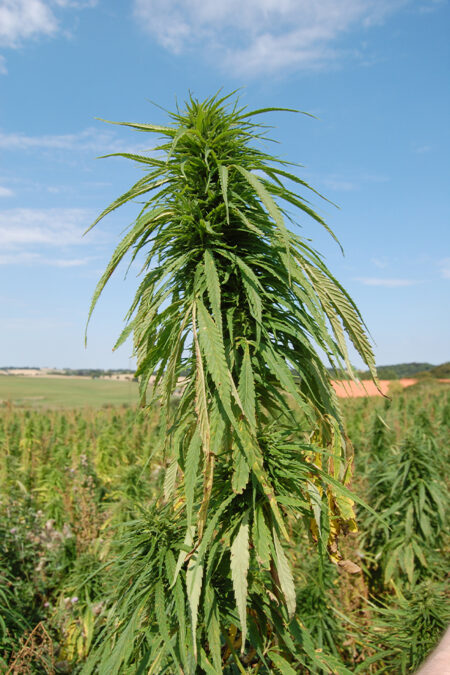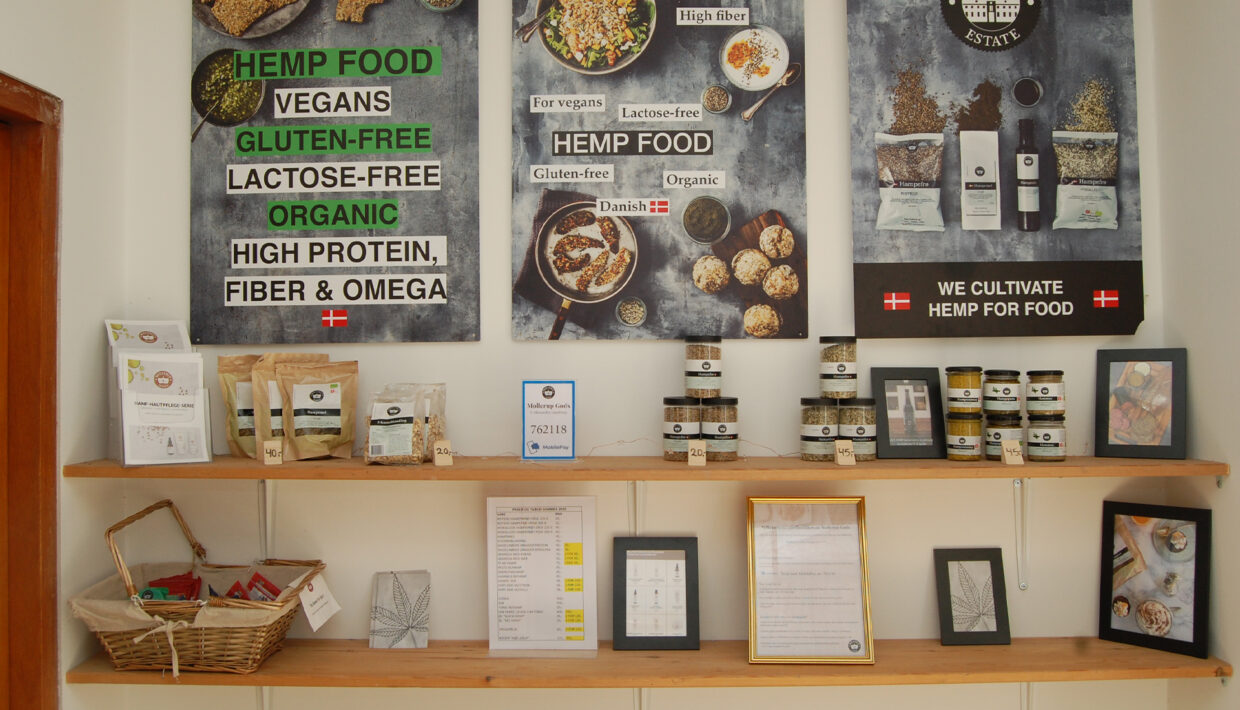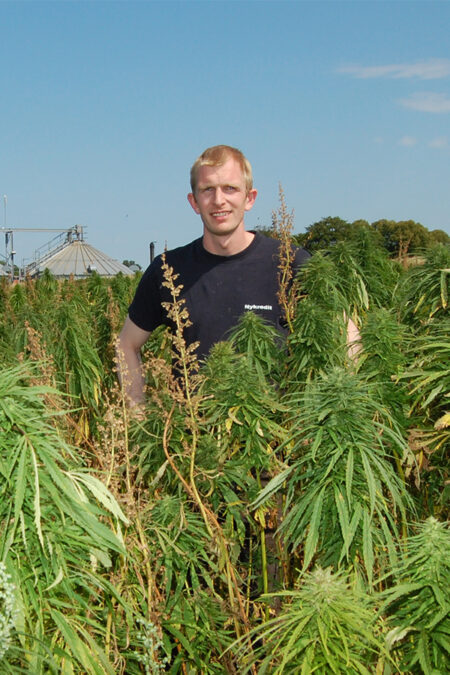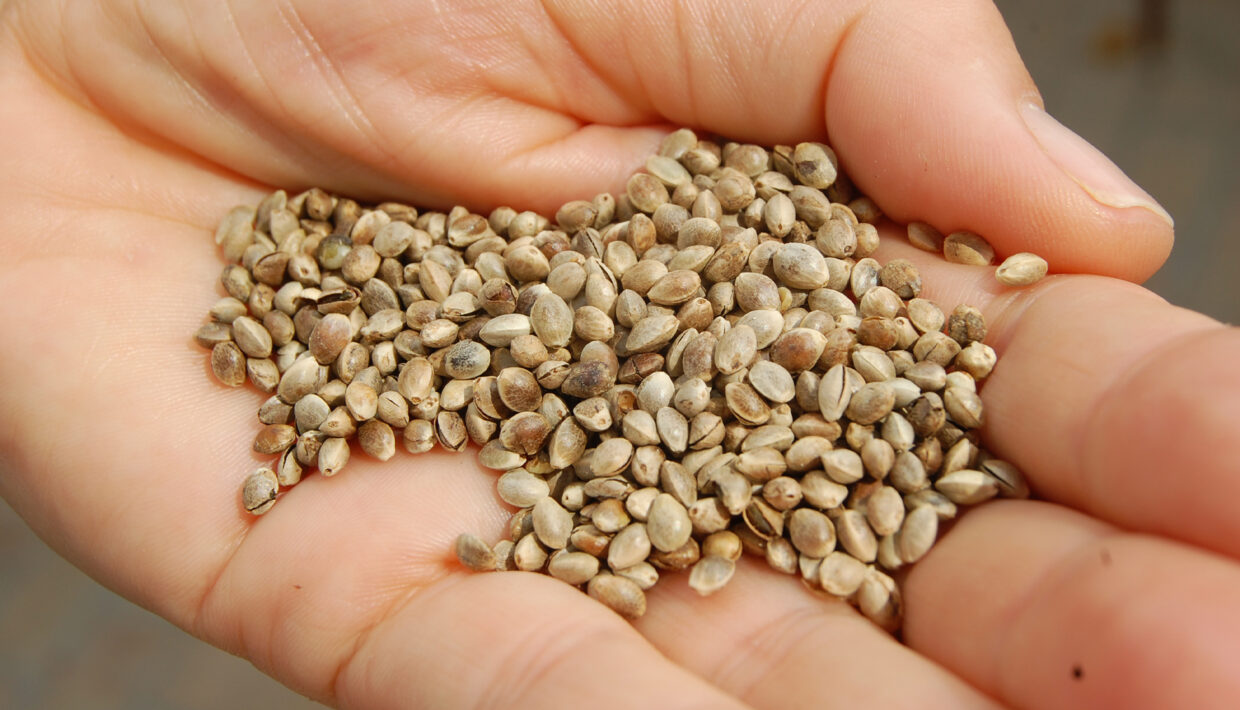When a trendy young shopper returns from the local supermarket with a jar of hemp pesto in her bag, or when she is massaging her face with an anti-aging facial moisturiser made with hemp oil, there is a direct link to an estate in southern Djursland, one with a very long history.
As a matter of fact, the history of Moellerup Estate in Denmark goes back to the days when King Erik Klipping was killed in Finderup Lade in 1286, and the then-owner of Moellerup, Marsk Stig, was convicted of the killing and outlawed. That Mr Stig might have been set up is another issue, one which will probably never be solved.

Hemp of the type grown at Moellerup Estate can reach a height of up to two metres.
In any case, the property of the accused king killer now supports a small group, centred around a crop that went long unused in Danish farming, but which has now returned. Hemp.
Hemp is a fantastic crop. You can do everything with hemp
Anne Sophie Gamborg
“Hemp is a fantastic crop,” says Anne Sophie Gamborg, whose family has owned Moellerup since 1920. “You can do everything with hemp,” she continues enthusiastically.
“You can produce food from the seeds, medication from the leaves, and textiles, rope and many other things from the stems. When the Vikings arrived in Vinland, in what is today Canada, they brought hemp seeds that were planted immediately. Otherwise, they could not produce ropes and sails to return home,” she explains.
Rich in protein and oil
It’s not for the production of rope and sail that hemp is grown in Djursland today. Moellerup and associated partners are producing it for the seeds. These are marketed, among other things, for being richer in protein than other plants and for containing all of the nine essential amino acids needed by the human body. Hemp oil also has a high content of the beneficial omega-3 fatty acid in a perfect ratio to other types of fatty acids.
Following light treatment, the seeds can be used in an endless number of food products, and hemp oil can be used for skin care products.
After harvest, the seeds are dried to 9% water content for optimum storage. They are subsequently transported to the factory run by Moellerup in Nors near Thisted, where they are peeled, roasted, ground into flour, or pressed into oil. Now the seeds can be used in flour mixes, mustard, salami, pesto, tea, beer, gin and other good things.
Four businesses in the attic
The attic above the estate’s old horse stables has been converted into a modern office environment for the employees of four hemp-related businesses, established by Mrs Gamborg, her husbond Stig Gamborg and their children over the past 15 years.

The farm shop provides information about hemp for food use.
The small group has a clear business strategy, even if it did all start by coincidence when Mrs Gamborg completed her training as a manager at the ecological farming school at Kaloe when she was about 40. She wanted to improve the farm, but had no intentions of turning Moellerup into an organic venture. “Our loamy soil is too good for that. Our yields would drop too much, and I am highly focused on sustainability,” she explains.
She had no intentions of turning Moellerup into a centre for hemp either, even if she did choose that crop as the topic for her final paper.
“I just thought it would be fun to write about hemp, and it could be cool to show my children and the younger students that someone my age could be aware of this.” But the conclusion of her paper was that a yield of only around 1t/ha of hemp seed was possible. “Thus, it made much more sense to grow other crops.”
Building proprietary machinery
Despite this, the final paper did lead the way for hemp on the old estate. Based on her paper, Mrs Garmborg had contact with Bodil Pallesen, then a consultant with expertise in hemp, at the Agricultural Advisory Centre. Through her, she got to know a woman in Horsens who had invented technology to extract fibres from hemp stems and other plants.
This sparked the entrepreneurial spirit in the Gamborg family. Together with the inventor from Horsens, the local blacksmith in the neighbouring village and the family’s au-pair’s boyfriend, Mr Gamborg build the first machine according to the inventor’s new principles. And it worked!
At first, the machinery was located in an old barn at Moellerup; later it was moved to the factory in Nors. The technology can be used for all kinds of raw materials containing fibres, not just hemp. It may be textiles, old car tyres, paper or wood. Actually, most raw materials are cheaper than hemp. So even if the technology has led to good business in the Moellerup companies Advance Nonwoven and Convert A/S, it did not lead to hemp growing in the fields of Moellerup.

Emil Marcus Pedersen, Farm manager at Møllerup.
Hemp in more and more fields
In 2014, inspiration from Canada led to the Gamborg family seeing possibilities in hemp as a foodstuff with very special qualities, fully compensating for the relatively small yield. In 2015 they started growing hemp on 30ha, and it took off from there. In 2019 they were growing the crop on 220ha of Moellerup land, plus 280ha at co-operating organic farms. By 2020 the partners’ total ecological hemp area grew to 400ha.
Even in conventional production, no pesticides are allowed at all in hemp. Despite that, there are no major problems with fungi, pests or weeds.
Hemp works well in rotation with grain.
Emil Marcus Pedersen, Farm manager.
“We did have some meldweed, mugwort and some thistle in a field, where as a test we were growing hemp continuously for five years,” explains the manager at Moellerup, Emil Marcus Pedersen.
In rotation with grain, it is no problem keeping the weeds at bay. If the plant gets off to a good start, hemp grows quickly to the height of a person and outcompetes the weeds. A good start requires the addition of 100kg N of manure or liquid ammonia per hectare, during seeding in mid- or the end of May. But the weather should also give a helping hand. Hemp must be seeded shallow thus the germination may be hurt by drought or cold. Harvest takes place 120 days after seeding, so the final half of September.
Hemp has a long taproot, and according to Mr Pedersen, it does provide a good base for the next year’s crop. You could say that the plant has also provided a good base for the recent development at the old estate of Marsk Stig.
Moellerup Estate
- Owned by the Hvide family for 500 years.
- Taken over by Anne Sophie and Stig Gamborg in 2002.
- Located in the northern part of the national park Mols Bjerge, near Roende in Djursland.
- Acquired by Anne Sophie Gamborg’s great grandfather and shipowner Poul Carl in 1920. In the hands of the same family since then.
- The agriculture is pure plant production with grass seed, grain and hemp.
- The hemp is the Finola type, which has no euphoric effect.
- 370ha crops and 110ha forest.
- 1200 hemp-related businesses, hunting, horse livery, rentals, farm shop and webshop.



